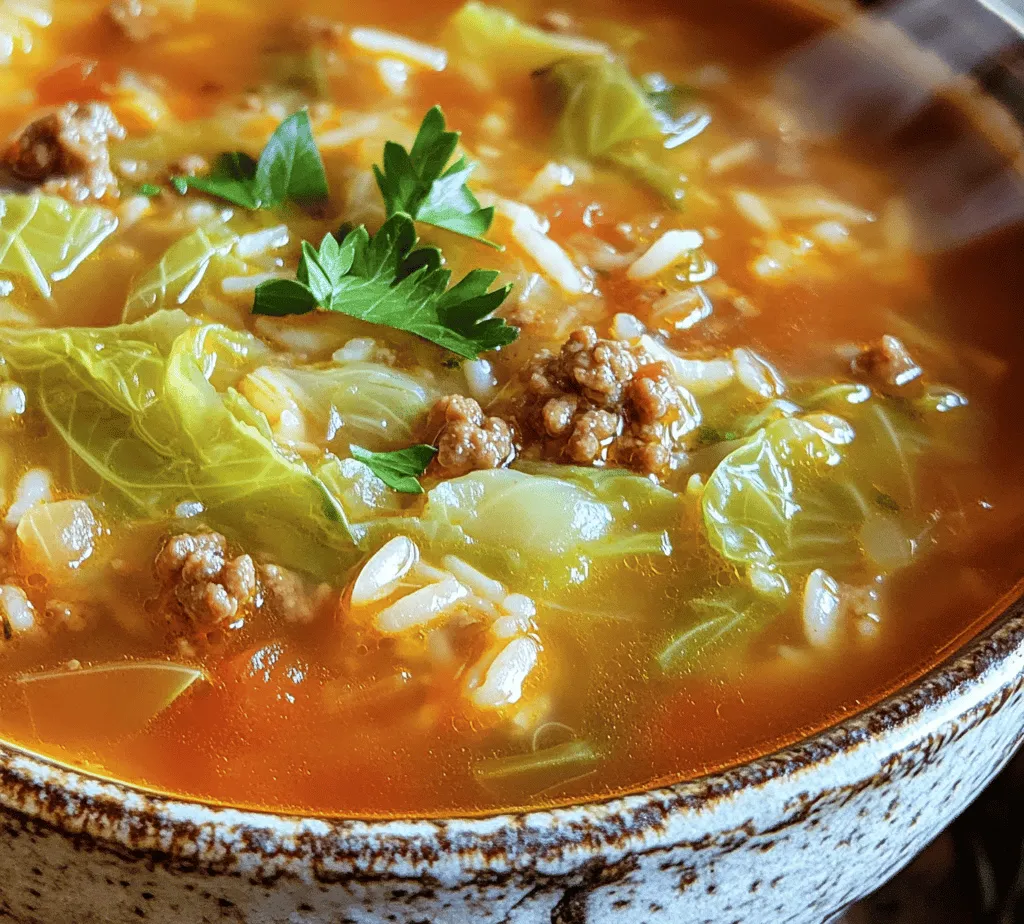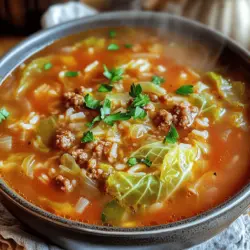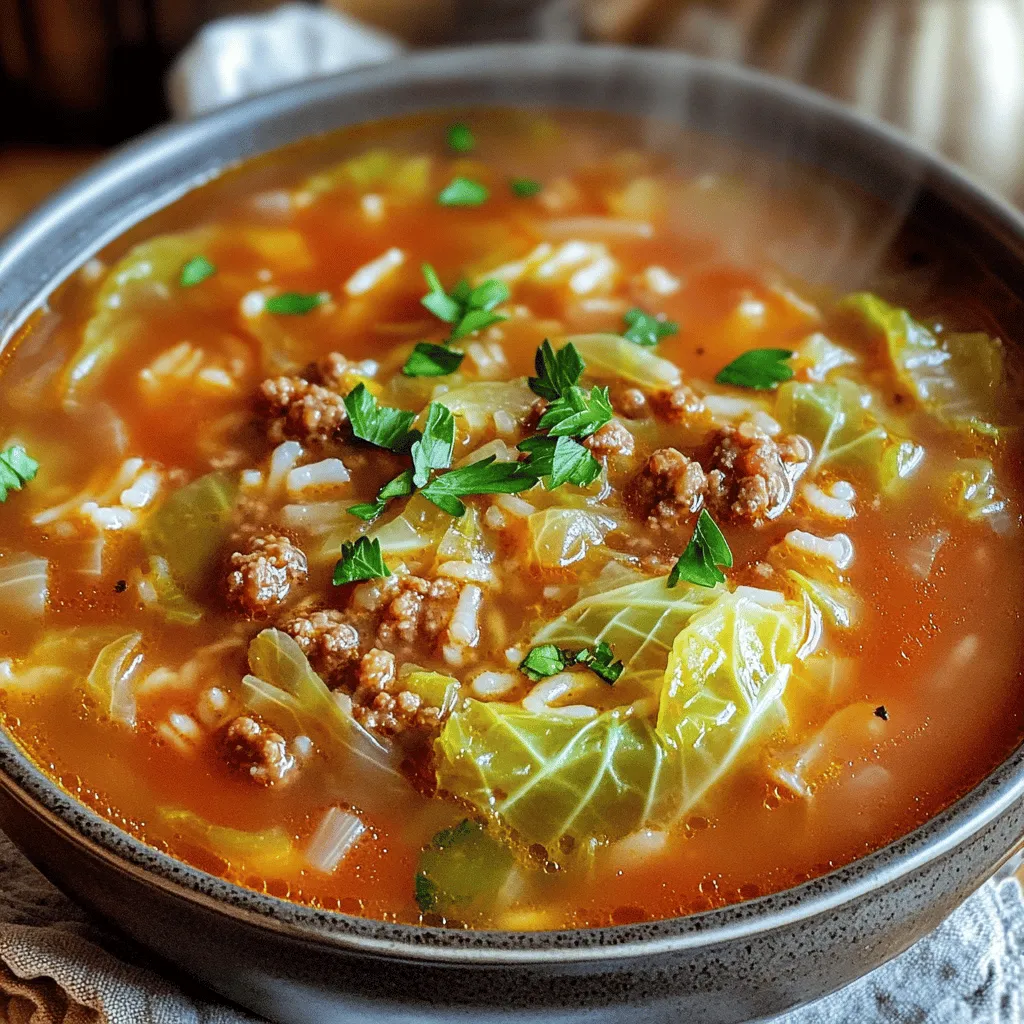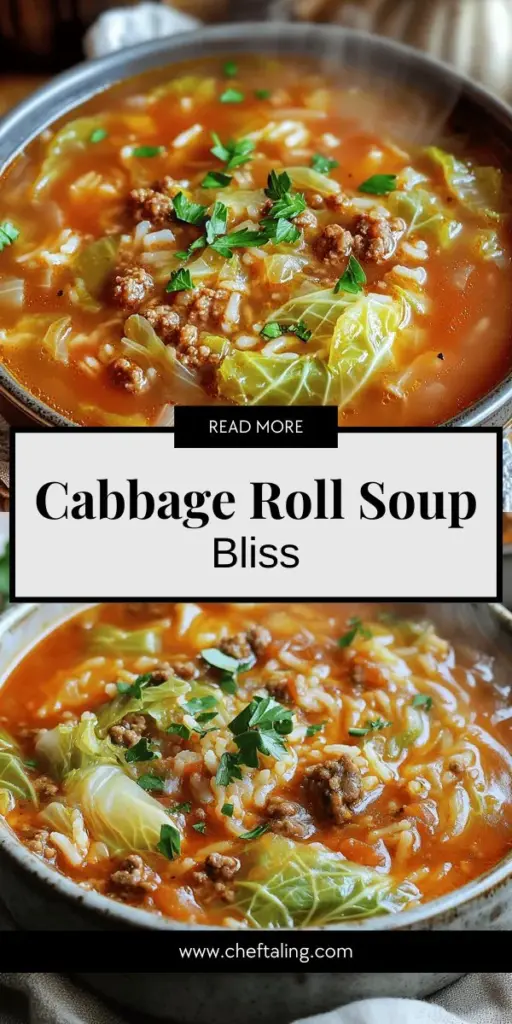Introduction to Cabbage Roll Soup Delight
Cabbage Roll Soup is a delightful and comforting dish that encapsulates the essence of traditional cabbage rolls in a simplified, easy-to-make soup form. This recipe takes all the beloved flavors of stuffed cabbage and transforms them into a warm, nourishing bowl that is perfect for family dinners or meal prep. With its robust flavors and hearty ingredients, Cabbage Roll Soup not only satisfies the palate but also warms the soul, making it an ideal meal for cold weather or when you simply need a comforting dish.
One of the key benefits of Cabbage Roll Soup is its impressive nutritional value. Cabbage, a primary ingredient, is packed with vitamins K and C, fiber, and antioxidants. When combined with lean protein, such as ground beef or turkey, and whole grains like rice, this dish becomes a well-rounded meal that provides essential nutrients for your body. Moreover, its ease of preparation allows even novice cooks to whip up a batch without much hassle, making it a go-to recipe for busy weeknights or gatherings.
This dish is also incredibly versatile, accommodating various dietary preferences. Whether you prefer ground beef for its rich flavor or a leaner option like ground turkey, the choice is yours. Additionally, you can opt for either white or brown rice, catering to your personal taste or dietary needs. With countless variations available, you can customize your Cabbage Roll Soup to suit your family’s preferences or even experiment with different spices for a unique twist.
Understanding the Ingredients
To fully appreciate the flavors and textures of Cabbage Roll Soup, it’s essential to understand the key components that make up this delicious recipe. Each ingredient plays a crucial role in creating a harmonious blend of taste and nutrition.
Cabbage
Cabbage is the star of this soup, providing not only bulk but also a distinctive texture that enhances the overall experience. This leafy green vegetable is a nutritional powerhouse, rich in dietary fiber, vitamins C and K, and several minerals including potassium and calcium. The high fiber content in cabbage aids in digestion and contributes to a feeling of fullness, making this soup a satisfying option for those looking to maintain a healthy diet. When cooked, cabbage softens beautifully, adding an earthy sweetness to the broth while retaining a slight crunch that elevates the soup’s texture.
Ground Beef or Turkey
The choice of protein in Cabbage Roll Soup plays a significant role in determining its flavor profile and nutritional content. Ground beef, known for its rich, savory taste, adds depth and a satisfying heartiness to the dish. On the other hand, ground turkey is a leaner alternative that offers a lighter flavor while still providing ample protein. Each option has its merits, and your choice will depend on your dietary preferences or health goals. The fat content in ground beef contributes to a more indulgent soup, while turkey keeps it leaner, which may be appealing for those watching their fat intake.
Rice
Rice serves as a crucial ingredient in Cabbage Roll Soup, contributing to the dish’s heartiness and making it even more filling. You can choose between white rice and brown rice, each bringing its unique characteristics to the table. White rice cooks faster and has a softer texture, while brown rice is slightly chewier and offers more fiber and nutrients due to its whole grain nature. The choice of rice can affect the overall satiety of the soup, with brown rice providing a more substantial feel, making it a great option for those seeking a more wholesome meal.
Aromatics: Onion and Garlic
No soup is complete without the foundational flavors provided by aromatics, and in this recipe, onion and garlic are essential. Sautéing these ingredients enhances their natural sweetness and aroma, creating a fragrant base for the soup. Onions add a subtle sweetness, while garlic contributes a robust flavor that permeates the entire dish. Together, they elevate the taste profile, making each spoonful of Cabbage Roll Soup a flavorful experience.
Tomato Products
Tomato products play a significant role in Cabbage Roll Soup, adding acidity, sweetness, and a vibrant color. Crushed tomatoes and tomato sauce form the soup’s base, providing a rich, tangy flavor that complements the other ingredients. The acidity from tomatoes helps balance the dish, cutting through the richness of the meat and adding depth to the overall taste. Additionally, the natural sweetness of tomatoes enhances the flavor of the cabbage and creates a well-rounded, comforting soup.
Broth and Seasoning
A flavorful broth is the foundation of any great soup, and in Cabbage Roll Soup, it provides essential moisture and richness. While you can use store-bought broth, making your own or using a high-quality stock will yield the best results. The seasoning is equally important; Worcestershire sauce adds a complex umami flavor, while dried oregano and smoked paprika impart warmth and depth to the dish. These seasonings work together to create a robust flavor profile that perfectly complements the ingredients, making each bite a delightful experience.
Step-by-Step Cooking Instructions
Now that we’ve explored the ingredients and their significance, it’s time to delve into the cooking process. This Cabbage Roll Soup recipe is designed to be straightforward, allowing you to create a delicious, hearty meal with minimal fuss. Here’s a detailed walkthrough of the initial cooking steps that will set the stage for a flavorful and satisfying soup.
Sautéing the Aromatics
1. Heat the Oil: Begin by heating a tablespoon of olive oil in a large pot or Dutch oven over medium heat. Olive oil is an excellent choice for sautéing due to its flavor and health benefits.
2. Add the Onion: Once the oil is shimmering, add a finely chopped onion to the pot. Sauté the onion, stirring occasionally, until it becomes translucent and tender, about 5-7 minutes. This process caramelizes the sugars in the onion, enhancing its sweetness and flavor.
3. Incorporate the Garlic: After the onion has softened, add minced garlic to the pot. Sauté for an additional 1-2 minutes, stirring frequently to prevent the garlic from burning. The aroma of the garlic will fill your kitchen, laying a flavorful foundation for the soup.
4. Brown the Meat: Increase the heat to medium-high and add your choice of ground beef or turkey to the pot. Break the meat apart with a spatula and cook until browned, about 5-8 minutes. Ensure to cook the meat thoroughly, stirring occasionally. If using beef, you may need to drain excess fat once it’s browned to keep the soup from becoming overly greasy.
By taking the time to properly sauté the aromatics and brown the meat, you are building the essential flavors that will permeate throughout the soup, setting the stage for a rich and satisfying dish. In the following steps, you’ll add the remaining ingredients that will transform this base into a delightful Cabbage Roll Soup.
Stay tuned for the next part of this recipe, where we will continue to build on the flavors and complete this delicious dish!

Sautéing Onions and Garlic
The foundation of any great soup often begins with the simple yet transformative act of sautéing onions and garlic. This technique not only enhances the aromatic profile but also contributes to the overall depth of flavor in your Cabbage Roll Soup Delight. When you sauté onions, they become sweet and translucent, releasing their natural sugars, while garlic adds a sharp, savory bite that elevates the dish. Together, they create a fragrant base that invites the other ingredients to shine.
To achieve the best results, heat your olive oil in a large pot over medium heat. Add the chopped onions first and let them cook for about 3-5 minutes until they start to soften. Then, introduce minced garlic, stirring it in just until fragrant, which usually takes about 30 seconds. Be cautious not to burn the garlic, as this can lead to an unpleasant bitterness in your soup.
Browning the Meat
Next, it’s time to add the ground meat to your sautéed mixture. Browning the meat is a crucial step that significantly enriches the overall flavor of the soup. This process, known as the Maillard reaction, occurs when proteins and sugars in the meat react to high heat, resulting in a rich, caramelized exterior.
To brown the meat effectively, increase the heat to medium-high and add the ground meat to the pot. Break it up with a wooden spoon, ensuring even cooking. Cook until it is fully browned, which should take about 5-7 minutes. Not only does this step enhance the flavor, but it also adds a satisfying texture to the soup. Once browned, drain any excess fat if necessary, and continue to the next step.
Incorporating Cabbage
With the meat beautifully browned, it’s time to add the star ingredient: cabbage. Incorporating cabbage into the soup is not just about flavor; it’s also about texture and nutrition. To achieve the desired tenderness without losing the cabbage’s nutrient profile, it’s essential to add it at the right time.
Chop the cabbage into bite-sized pieces and add it to the pot after browning the meat. Stir well to combine, allowing the cabbage to wilt slightly and absorb the flavors from the meat and aromatics. This should take about 3-4 minutes. It’s important to avoid overcooking the cabbage, as you want it to retain some crunch and its vibrant green color, all while providing a wealth of vitamins and minerals.
Building the Soup
Now that the base is established with sautéed onions, garlic, browned meat, and cabbage, it’s time to build the soup with additional ingredients. Start by adding canned diced tomatoes, which contribute acidity and sweetness, balancing the richness of the meat. Pour in the broth—be it chicken, vegetable, or beef—depending on your preference, as it forms the soup’s heart.
Next, add uncooked rice to the mixture. The rice not only contributes its own flavor but also thickens the soup and makes it more satisfying. Stir everything together, ensuring the rice is evenly distributed throughout the soup. A good stir will encourage the flavors to meld together beautifully.
Simmering for Flavor Development
Once all the ingredients are combined, it’s time to let the soup simmer. Lower the heat to medium-low and cover the pot, allowing the soup to simmer for at least 30 minutes. This step is crucial for flavor development; during this time, the rice will cook and absorb the broth while the flavors from the meat, cabbage, and tomatoes deepen and mingle.
Check the soup occasionally, stirring gently to prevent sticking. If you find it too thick, feel free to add a little more broth or water to reach your desired consistency. After the simmering period, the soup should be hearty and fragrant, ready for the final adjustments.
Final Adjustments and Serving
Before serving, it’s essential to taste the soup and adjust the seasoning as needed. A sprinkle of salt and a dash of pepper can make a world of difference. If you prefer a hint of acidity, consider adding a splash of lemon juice or a teaspoon of vinegar to brighten the flavors.
For an appealing presentation, ladle the soup into bowls and garnish each serving with freshly chopped parsley. Not only does this add a pop of color, but the fresh herbs also enhance the overall flavor, offering a hint of brightness that balances the richness of the soup.
Nutritional Information
Each serving of Cabbage Roll Soup Delight is not only delicious but also packed with nutrition. Here’s a breakdown of the approximate nutritional content per serving:
- Calories: 350
- Protein: 25g
- Fat: 15g
- Carbohydrates: 32g
- Fiber: 5g
This soup fits beautifully into a balanced diet, offering a rich source of protein from the meat, fiber from the cabbage and rice, and a variety of vitamins and minerals. The presence of cabbage, in particular, contributes antioxidants and may support digestive health.
Storage and Reheating Suggestions
If you find yourself with leftovers, storing your Cabbage Roll Soup Delight is simple. Allow the soup to cool completely before transferring it to an airtight container. It can be stored in the refrigerator for up to 4 days or frozen for up to 3 months.
When reheating, the best method is to use a pot on the stove over low to medium heat, stirring occasionally to maintain even heat distribution. If the soup has thickened during storage, add a splash of broth or water to regain the desired consistency. Alternatively, you can reheat individual portions in the microwave, ensuring to cover the bowl to prevent splatters.
Variations and Substitutions
Cabbage Roll Soup is incredibly versatile, allowing for various adaptations to suit different dietary preferences and restrictions. For a vegetarian option, simply replace the ground meat with plant-based protein like lentils or chickpeas. You can also use quinoa or farro in place of rice for a whole grain alternative.
If you want to add some heat, consider incorporating red pepper flakes or a dash of hot sauce. You can also experiment with different types of broth, such as mushroom or bone broth, to alter the flavor profile. Additionally, seasonal vegetables like carrots or bell peppers can be added for extra nutrition and color.
Conclusion
Cabbage Roll Soup Delight is more than just a meal; it’s a heartwarming dish that brings comfort and satisfaction to the dining table. With its rich, savory flavors and wholesome ingredients, this soup is perfect for family gatherings or cozy nights in.
The ease of preparation combined with the nutritional benefits makes it a go-to recipe for busy weeknights or meal prepping for the week ahead. Whether you stick to the classic recipe or explore creative variations, this soup is sure to become a beloved staple in your culinary repertoire. Enjoy the warmth and goodness that Cabbage Roll Soup Delight brings, making it a cherished dish for everyone at your table.


